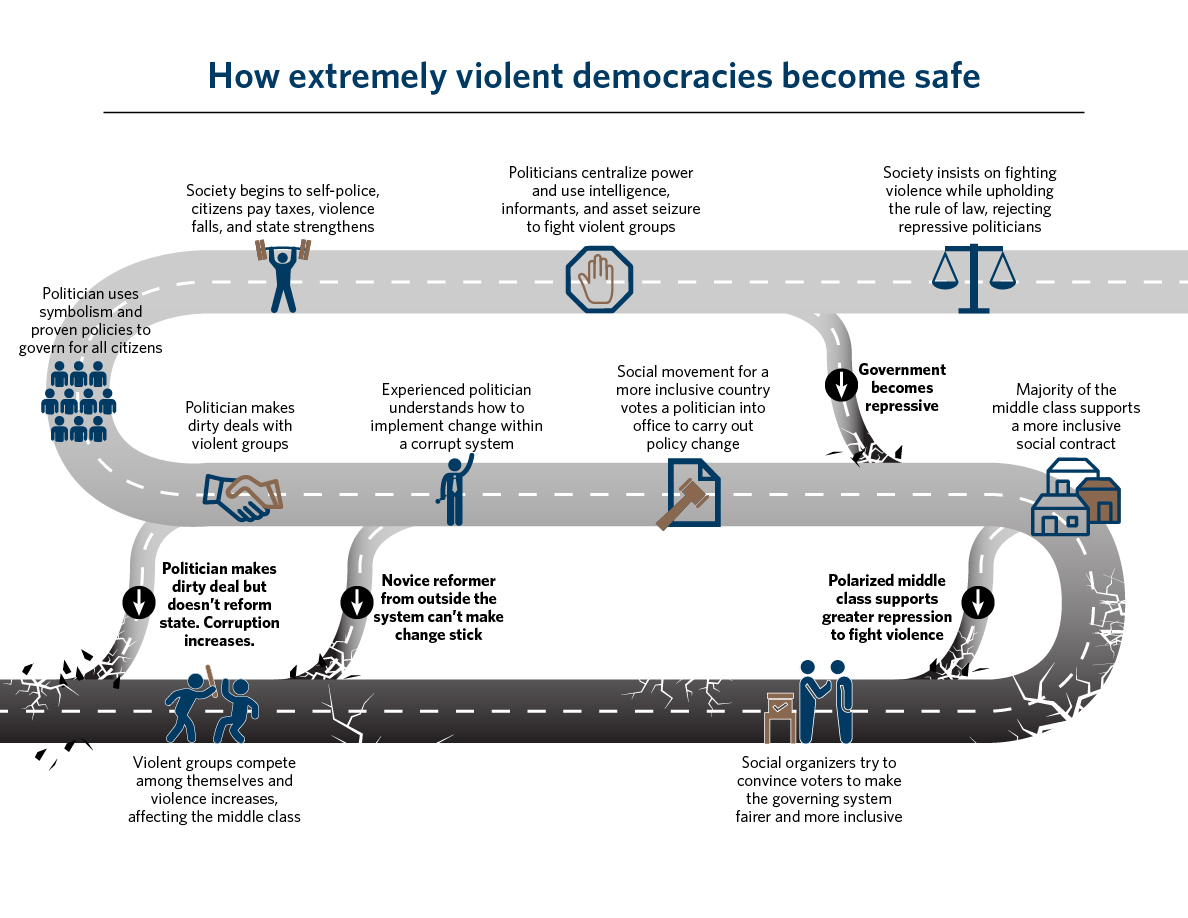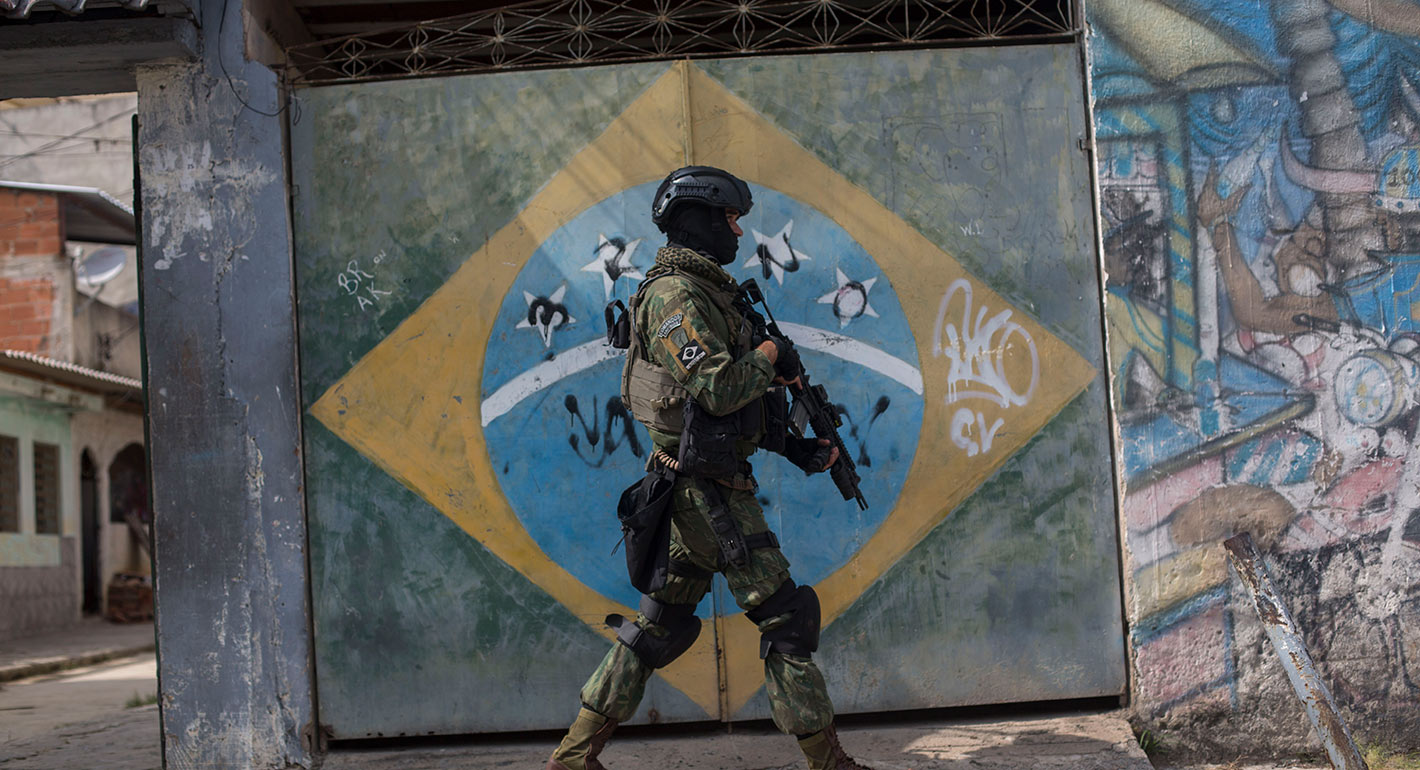When you started writing your book on extremely violent societies, A Savage Order, what did you want to find out?
Most research explains why violence is so difficult to get rid of, but doesn’t say how to do so. The usual policy solutions trotted out by think tanks and governments—like training militaries and offering them better security equipment—keep failing.
I wanted to know if there was a practical way to make extremely violent places safer.
I began by holding a conference with the World Justice Project, Stanford University, and the world’s most renowned experts on fighting violence. We produced a literature review of well-researched technical solutions.
But when I asked the room of experts how to get these proven strategies adopted by an unscrupulous police force, there was utter silence.
The real question, I realized, wasn’t how to fight violence—it was how to get a corrupt government to want to do so.
Which parts of the world did you choose to look at, and why?
I chose to look at struggling democracies. They are the world’s most violent countries, and I wanted to know why.
When people think of violence, they think of war. But about 83 percent of violent deaths now occur outside conflict zones. From 2007 to 2014, more civilians died violently in Mexico than in Iraq and Afghanistan. In 2015, Brazil had more violent deaths than Syria.
Some people blame democracy itself for violence. But why wouldn’t governments that supposedly answer to voters do a better job of protecting their citizens? I wanted to understand what was happening.
I picked pairs of societies around the world as case studies: one that has recovered from violence, and one that has not.
For example, I visited Colombia to find out why it had become so much safer, while Mexico was at its most dangerous point in fifty years. I went to the Republic of Georgia and contrasted it with Tajikistan. In India, I considered why Bihar—a state once wracked by crime and Maoist insurgency—got better, while Jharkhand, its neighbor to the south, did not. I traveled across Italy to learn why Sicily was able to weaken its mafia, while Naples had not. In Africa, I went to Ghana to figure out why it stayed mostly peaceful, despite economic collapse and coups, while Nigeria suffered from multiple types of violence.
I also looked at the United States after our Civil War, to understand why the Wild West was tamed so quickly, while violence skyrocketed in the South.
The Wild West just lacked enough government to enforce the law. As the state grew stronger, violence fell.
By contrast, in the South, as government got stronger, violence rose. That’s because former Confederate politicians allowed violent groups like the Ku Klux Klan to operate, creating a culture of fear that helped the politicians squash opposition and regain power. By 1892, almost three decades after the war, there was a lynching every thirty-six hours.
This historical example offered the key to the puzzle.

Did you see a similar pattern in violent countries around the world?
I had chosen very different cases, expecting they would show very different problems. Instead, I found startling similarity.
A handful of violent democracies are just weak states, like the Wild West. But far more common are democracies that have become violent because politicians provide impunity to organized criminals. Sometimes, the deal is to allow violence in exchange for bribes—such as when a drug cartel funds a political campaign. In other places, politicians might hire gangs at election time to stop people from voting for the opposition, and then allow the gangs to commit crime between elections without being punished.
Take Venezuela, now the most violent country in the world. The Venezuelan minister of justice has been indicted by the U.S. Drug Enforcement Administration for drug smuggling, and the military is riddled with cartel connections. So when the cartels commit violence against citizens, the government isn’t going to prosecute. Meanwhile, the government hires thugs, known as collectivos, to intimidate opposition leaders.
Most people think that extremely violent democracies, such as Honduras or El Salvador, are too weak to fight the violence that overwhelms them. The United States sends them billions in aid and security cooperation. But the security services of these countries have been deliberately undermined, so money and training won’t help.

Were there also similarities between places that have become safe?
Yes. All had middle classes who realized the governing order was rotten, and banded together to change not just their politicians but the structure of their government, so that it was more inclusive, less corrupt, and provided security to everyone.
For example, in Colombia in 1990, after drug cartels murdered three presidential candidates and hundreds of police, millions of Colombians took to the streets demanding a new constitution. The new document enshrined human rights and a constitutional court. It also allowed independent politicians to run for office, breaking the stranglehold of the colluding political parties.

Twelve years later, that paid off. In 2002, Álvaro Uribe won the presidency as an independent candidate and started to fight violence in earnest. A few months later, an independent mayor won office in Medellín, Colombia’s most violent city, and poured funds into public transport, concerts, and architecture that tied the poor hillside slums to the rest of the city and built a sense of community and pride.
Were there any surprising differences between countries?
The biggest difference was the importance of society itself. In Ghana, for instance, when the government fell apart in the 1970s, people ate grass to avoid starvation. There was tension between a poor, Muslim north and a richer, Christian south—the kind of fissures that could have cracked open.
But politicians didn’t incentivize violence or use identity as a campaign slogan. And traditional leaders—chiefs, pastors, imams—all supported a strong, cohesive society. So there was no violence, despite the state lacking nearly any way to keep order for a few years.

Most people don’t want to kill anyone, and societies largely police themselves. As long as politicians aren’t giving violent people impunity or encouraging repressive, predatory police, societies that maintain cohesion can stay peaceful even with a weak, poor state.
Why do certain countries become violent, even if they aren’t at war?
Violence takes root in highly unequal, polarized democracies. Politicians and business leaders want to keep power. But if they are corrupt, they can’t necessarily win fair elections. So they fill their campaign coffers with donations from organized criminals, use gangs to intimidate opposition voters, and collude with violent groups to make sure they stay in power, despite the supposed “democracy.”
They also have to keep the violent groups that help them out of jail. So they politicize the police. Instead of promoting officers on merit, top jobs go to people who will follow their orders. This makes the force corrupt and brutal.
Predatory police, and a government that won’t protect everyone, opens space for gangs, vigilante groups, and mafias to market themselves as justice for the poor. Murder rates grow—in Mexico, more than 95 percent of murders go unsolved. Violence becomes normal. Knowing they won’t be punished, businesses hire assassins to kill activists, and neighbors kill each other to resolve disputes.
Once a place becomes violent, how can it become safe again?
In these countries, violence begins with the government and with organized, professional criminals. But it metastasizes into widespread social violence between regular people.
To fix it, the middle class—who generally aren’t targeted, and protect themselves from spillover violence with gated communities and private security—must decide that they don’t want so much bloodshed in their country.

Next, social organizers have to convince the middle class that greater repression isn’t the answer—that, instead, the government should start treating all of its citizens fairly. If an honest politician is running, and the middle class votes for a unified society, then the country has a chance.
If a new government decides to fight organized violent groups while simultaneously convincing people that it wants to keep them safe and govern fairly, society can start to self-police. Then social violence—the kind of murders that start with someone drunk in a bar or angry with a boss—begins to decline.
What does the task of making a violent country safer look like?
The process is messy. At first, any new government must work through corrupt security services and bureaucracies, and offer sweetheart deals to violent groups. Sometimes these are formal peace treaties, sometimes criminal amnesties, or plea bargains with despicable people.
These deals have to happen—there is no other way for weak states to gain breathing room. But the agreements are unjust, and open up the possibility that the government could fall back into corruption. So they must be overturned quickly, before the rot leads to a fresh round of violence.
For instance, in the Republic of Georgia in the early 1990s, president Eduard Shevardnadze’s government was so weak that the only way to tame the militias devastating the country was to let the two main warlords control different ministries and make money from their government posts.
That helped reduce violence at first, but led to such immense corruption that terrorism and organized crime began to take root. So a new government needed to take the next steps. Mikheil Saakashvili launched the Rose Revolution to overturn the old order. When he became president in 2003, he centralized power and used wiretaps, surveillance, and force to fight Georgia’s mafia.
This approach was necessary and worked stunningly well. But such tools are hard to wield just right, and politicians often go overboard and become repressive. So society has to rise up again to keep their governments on the path to security, not repression.
In the case of Georgia, Saakashvili’s zero tolerance policies increased prison populations by 300 percent in just four years. Accusations of prison torture and rape were rife. So people protested in the streets and eventually voted Saakashvili out, despite his heroic stature as the leader of their revolution.
When you were researching the book, did you find out anything you didn’t expect?
I don’t create a hypothesis and see if the facts fit. I start by learning all I can. So I began by traveling to these countries and interviewing exhaustively.
The most unexpected finding was the need for what I call “dirty deals.” Policymakers spend a great deal of time thinking about how to make peace deals that listen to everyone and satisfy all parts of society—which is good, and research shows this is the best way to make deals last.
But most people are only willing to give up violence if they get something in return—which means allowing some impunity or other gains for violent people. So we really need to spend more time thinking about what can be done next, to turn imperfect peace into a fair governing order.







